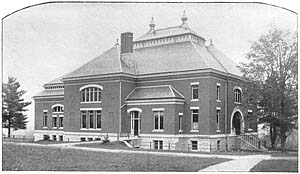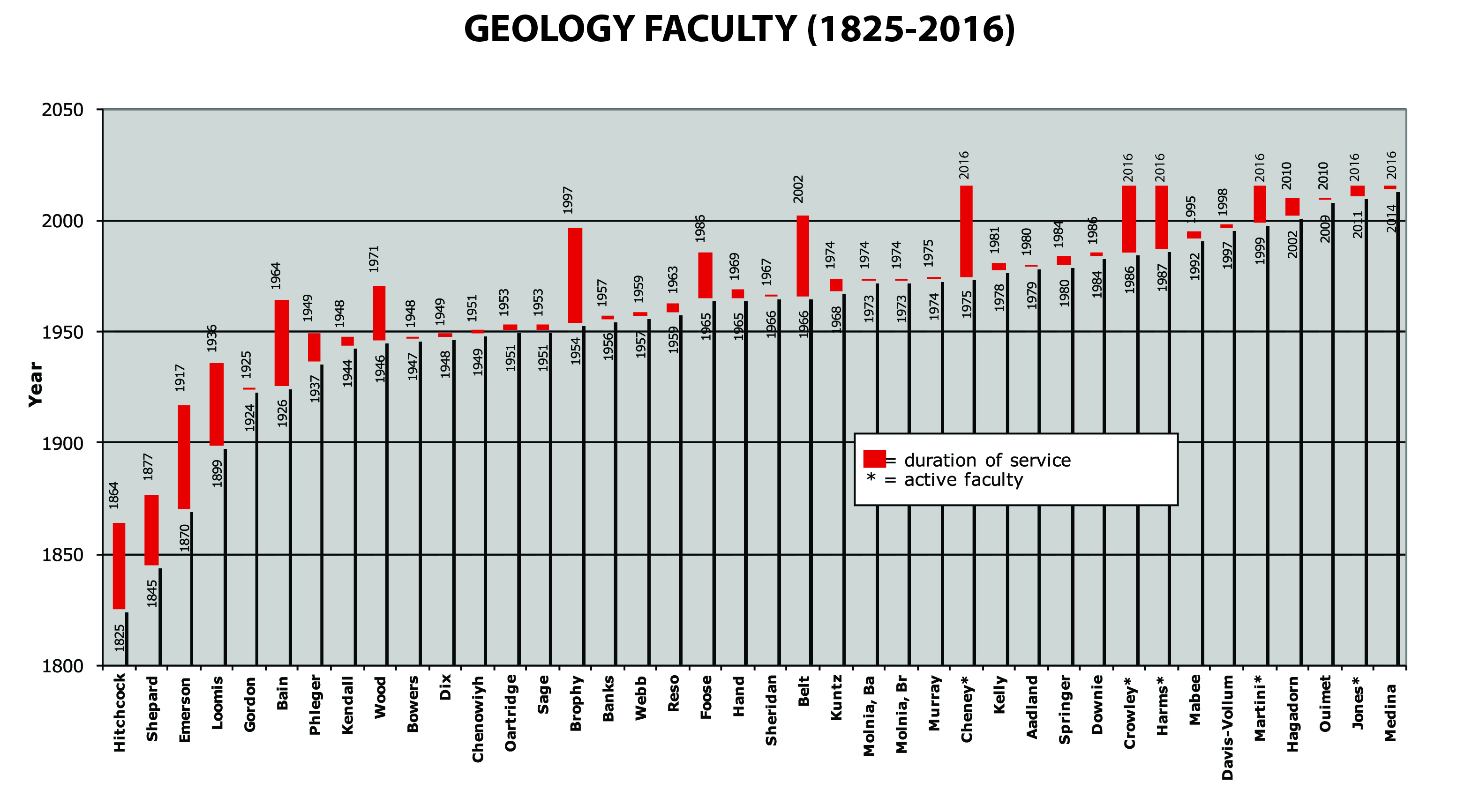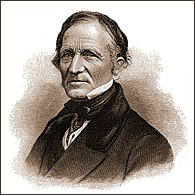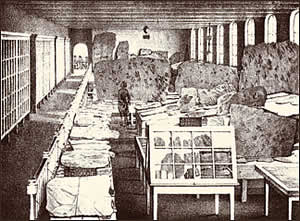
Although foresworn to uphold biblical interpretations of the earth, that did not prevent Hitchcock from making objective observations and scientific interpretations. For example, the outlines of major rock units by Hitchcock in Massachusetts can still be seen on the 1983 geologic map. He correctly interpreted the surficial clays of our valley as having been deposited in a large lake (named Lake Hitchcock by B. K. Emerson, his successor), he defined the meander-bend cut off and Oxbow lake in the flood of 1840, and deduced that the extraordinary elongated pebbles in the Dighton conglomerate were produced by metamorphic heating and stretching. He may have argued with Prof. Louis Agassiz at Harvard about the latter's proposal that continental glaciers had covered New England, first attributing the deposits to the Noachian flood. But by 1840 Hitchcock no longer believed that Diluvium resulted from Noah's flood (Lawrence, 1972, p. 30). Nevertheless he still argued for large lakes in New England. He and Agassiz, however, both agreed that Darwinian evolution was beyond the pale. Edward Hitchcock published the first geologic map of any state (actually, Massachusetts and Rhode Island) in 1832. The geologic map of Pennsylvania did not appear until 1833 (by the Rogers brothers)
Hitchcock was the founder of the College's Geology program (there were no departments on the campus until 1884). This program evolved by mid-century to include identification and interpretation of rocks and minerals, the mapping of rock formations, the creation of cross-sections, and the interpretation of sedimentary features such as the footprints of animals (i.e., trace fossils), ripple marks, mud cracks, etc. These are all aspects fundamental to our science today. From 1845 to 1877, teaching of geology courses was shared between Hitchcock and Charles Shephard (class of 1824). The latter also taught courses in Chemistry and Biology. Both Hitchcock and Shephard were avid collectors. The former collected dinosaur footprints, fossils and Indian relics, the latter, minerals and meteorites. These collections required the building of two "cabinets" (Octagon Mineralogical Cabinet and Observatory in 1841, now the Black Studies Center; Appleton Ichnological Cabinet in 1855, now Appleton Hall) for displaying the specimens that were so essential to the teaching of geology. Years later, Walker Hall (Chemistry) housed the mineral collection of Shephard. Much of that collection burned in the great fire of 1882. Edward Hitchcock died in 1864.
Five years after the death of Hitchcock, B. K. Emerson (class of 1865) came to the College and brought new life to a flagging program. B.K. received a Ph. D. degree from the University of Göttingen in 1868. The most sophisticated geology programs in the late 19th and early 20th Century were in Germany. Emerson wrote a report and made a geologic map of Old Hampshire County (1898), he revised the State geologic map (1917), and he taught Darwinian evolution! Finally, B.K. introduced for the first time, laboratory techniques, specifically for identifying minerals and rocks. He was not as avid a collector of fossils as his predecessors. But, he got an important collection of invertebrate fossils from John Clarke (class of 1877), New York State Paleontologist. The Clarke collection has formed the basis for one of the most comprehensive undergraduate study collections in the country, and still allows our teaching of Paleontology to be ahead of other colleges.
Because the teaching of evolution was not considered Christian at that time and because Amherst was a prolific producer of Congregational ministers, President Julius Seeyle in his 1877 inaugural address effectively prohibited the teaching of evolution on the campus! B.K. Emerson ignored the president and continued teaching evolution. Emerson's title in 1870 was Professor of Geology and Zoology...the latter apparently allowing him to express his views on evolution. Keep in mind that the Department of Biology at that time taught what today would be called Creationism. Then in 1880, President Seelye removed geology courses from the required curriculum. They were too radical! The College countered in 1884 by creating formal departments, and the title of ours became "Department of Mineralogy and Geology". As a department, our courses could be selected amongst a group of elective sciences. Seelye's stigma was thus removed.
Frederic Loomis (class of 1896) came to Amherst in 1899 and taught Biology and Comparative Anatomy until 1917 at which time he became the Hitchcock Professor of Mineralogy and Geology. Loomis was a Vertebrate Paleontologist, but he also taught other geology courses. He took Amherst students on over 18 digs in the U.S. and South America. He died at a dig in Alaska in 1937. Many of the Pratt Museum skeletons resulted from those expeditions.
Meanwhile, George Bain had come to Amherst in 1926, about 100 years after Hitchock had arrived. He retired in 1965. Bain, an economic mineralogist, was responsible during WWII for finding critical uranium deposits in South Africa. These deposits were needed in the construction of the atomic bomb. Bain taught structural geology, mineralogy, and geomorphology, and was assisted by Loomis who taught paleontology and evolution.
After WWII, the museum was moved out of Webster Hall (built in 1910), and Bain and Harlow constructed the present displays in the Pratt Museum. Also after the war, Albert Wood (taught from 1946 to 1970) from the Biology Department took over Loomis' role and taught Paleontology to geology students. George and Al also taught a unit in the old Science I course, required for all Amherst students of those days. With Bain as permanent department chair, few geology faculty stayed more than 3 years in the 38 years Bain taught at Amherst. The one that did was Gerry Brophy (who taught from 1954 to 1997). Brophy, an economic mineralogist, taught Mineralogy, Petrology, field geology, and the beginning course (Geol. 11). He was director of the Pratt Museum from 1965 to 1987.
In the early 1960’s, the explosion of geological knowledge and the push by President J. F. Kennedy for Americans to produce more and better scientists, prompted JFK's friend, Cal Plimpton, to replace George Bain as chair, bringing in "Pete" Foose (who taught from 1962 to 1986). Pete was an engineering geologist whose expertise lay in Structural Geology and geologic mapping. He also taught Geology 11. Ed Belt came to the department in 1966 a year after George Bain retired. The department at that time consisted of two tenured faculty and two Assistant Professors. Belt was hired to teach Invertebrate Paleontology because Bryce Hand was teaching Sedimentology. When Bryce left in 1968, Ed taught Sedimentology, Invertebrate Paleontology and Geomorphology. The last course gradually changed in the 1970's and by 1980 was called Environmental Geology. From 1987 until his retirement in 2002 Ed was Director of the Pratt Museum.

Edward Hitchcock


Hitchcock's Ichnological Cabinet
In addition to his work as a geologist, he was committed to teaching. Edward Hitchcock joined the faculty of Amherst College in 1825, just one year after its inception and before the college received a charter from the Commonwealth of Massachusetts. He taught for all of his years at Amherst even while he was President from 1845 to 1854. He authored Elementary Geology, a textbook that was used for 30 years, including 31 printed editions!
In the tradition of Amherst College he was not only a research scientist, but he was also deeply involved in Amherst community life. He helped found Mt. Holyoke College, The University of Massachusetts, The First National Bank of Amherst and the Amherst and Belchertown Railroad.
He was the son of a hatter in Deerfield, Ma. His interest in science began with astronomy and brought him to teach at Deerfield Academy where he became headmaster. He moved on to become Minister at the Congregational Church in Conway, Ma. It was here that he was offered the position of Professor of Natural Theology and Chemistry at the four-year-old Amherst College. Hitchcock himself never attended college but was awarded an M.A. from Yale in 1818 and a LL.D. from Harvard in 1840. He studied under Benjamin Silliman at Yale and continued contact with him through the 1830's (Lawrence, 1972).
Further Reading
Amherst Alumni Council News, 1929, A brief history of Geology and Mineralogy in Amherst College: The Alumni Council of Amherst College, Alumni Visiting Committee to the Department of Geology, Supplement to volume II, no. 3, 8 pp.
Cadbury, Deborah, 2000, The dinosaur hunters: Fourth Estate Press, London, 374 pp.
Cooper, Jason, 1990, Creation and Evolution: The Department of Geology at Amherst College: Unpublished senior honors thesis, Prof. Hugh Hawkins, advisor, 35 pp. and endnotes.
Fuess, Claude Moore, 1935, Amherst, The Story of a New England College: Little, Brown and Co.
Hitchcock, Edward, 1863, Reminiscences of Amherst College: Bridgeman and Childs.
Lawrence, P. J., 1972, Edward Hitchcock: The Christian geologist: Proceedings of the American Philosophical Society, v. 116, n. 1, p. 21-34.
Tuckerman, Frederich, unknown date, President Edward Hitchcock: Amherst Graduates Quarterly (found in Vol. 3 of the "Loomis Papers").